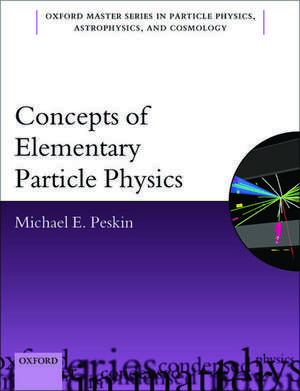Concepts of Elementary Particle Physics: Oxford Master Series in Physics, cartea 26
Autor Michael E. Peskinen Limba Engleză Paperback – 10 sep 2019
| Toate formatele și edițiile | Preț | Express |
|---|---|---|
| Paperback (1) | 304.70 lei 10-16 zile | +59.31 lei 6-12 zile |
| OUP OXFORD – 10 sep 2019 | 304.70 lei 10-16 zile | +59.31 lei 6-12 zile |
| Hardback (1) | 508.14 lei 31-37 zile | |
| OUP OXFORD – 29 aug 2019 | 508.14 lei 31-37 zile |
Din seria Oxford Master Series in Physics
- 10%
 Preț: 274.60 lei
Preț: 274.60 lei - 9%
 Preț: 280.93 lei
Preț: 280.93 lei -
 Preț: 237.06 lei
Preț: 237.06 lei - 9%
 Preț: 279.44 lei
Preț: 279.44 lei -
 Preț: 282.75 lei
Preț: 282.75 lei -
 Preț: 280.12 lei
Preț: 280.12 lei -
 Preț: 302.55 lei
Preț: 302.55 lei - 7%
 Preț: 296.66 lei
Preț: 296.66 lei - 8%
 Preț: 283.98 lei
Preț: 283.98 lei -
 Preț: 313.76 lei
Preț: 313.76 lei - 10%
 Preț: 274.77 lei
Preț: 274.77 lei -
 Preț: 281.49 lei
Preț: 281.49 lei - 11%
 Preț: 443.43 lei
Preț: 443.43 lei - 8%
 Preț: 281.15 lei
Preț: 281.15 lei - 9%
 Preț: 279.16 lei
Preț: 279.16 lei -
 Preț: 281.70 lei
Preț: 281.70 lei -
 Preț: 271.96 lei
Preț: 271.96 lei -
 Preț: 311.01 lei
Preț: 311.01 lei -
 Preț: 295.06 lei
Preț: 295.06 lei -
 Preț: 302.42 lei
Preț: 302.42 lei -
 Preț: 240.83 lei
Preț: 240.83 lei
Preț: 304.70 lei
Preț vechi: 326.72 lei
-7% Nou
Puncte Express: 457
Preț estimativ în valută:
58.32€ • 63.37$ • 49.02£
58.32€ • 63.37$ • 49.02£
Carte disponibilă
Livrare economică 19-25 martie
Livrare express 15-21 martie pentru 69.30 lei
Preluare comenzi: 021 569.72.76
Specificații
ISBN-13: 9780198812197
ISBN-10: 0198812191
Pagini: 400
Dimensiuni: 188 x 246 x 19 mm
Greutate: 0.83 kg
Editura: OUP OXFORD
Colecția OUP Oxford
Seria Oxford Master Series in Physics
Locul publicării:Oxford, United Kingdom
ISBN-10: 0198812191
Pagini: 400
Dimensiuni: 188 x 246 x 19 mm
Greutate: 0.83 kg
Editura: OUP OXFORD
Colecția OUP Oxford
Seria Oxford Master Series in Physics
Locul publicării:Oxford, United Kingdom
Recenzii
I field tested this new textbook in a senior-level course that introduces advanced undergraduates to elementary particle physics before they have had the formal training in quantum field theory that is usually needed to rigorously present many aspects of the Standard Model. I say usually, because in his new book, Professor Peskin adeptly manages to avoid this prerequisite, in a comprehensive, modern, and unique exposition that is a welcome addition to teachers of the subject at this level.
Peskin's book provides a perspective on the Standard Model of particle physics driven by observations. He presents just enough mathematical sophistication to connect the theoretical frameworks with their experimental consequences, allowing the reader to focus on the concepts. By recounting essentially every major particle physics discovery - often showcasing the original presentation of the data - he makes a compelling case for why we believe the laws of nature follow the rules of the Standard Model.
Prof. Peskin's Concepts of Elementary Particle Physics provides a concise and up-to-date mixture of theory and experiment that is much appreciated for books at the undergraduate level. In this book, the reader is led to discover the fundamental constituents of matter, from the Standard Model to what may lie beyond. This is done in an accessible way, as the book builds from the foundations up and provides chapter-by-chapter exercises to strengthen the understanding of the concepts and references to go more in detail.
A comprehensive, coherent, and thoroughly digestible presentation of the ideas that lie at the heart of modern-day particle physics. This book would be a welcome resource for any University physics student wishing to gain their first insights into the field.
This is a well written and much needed book that exposes undergraduates to the deep ideas, structure and principles of quantum field theory. It is a solid stepping stone for graduate work on the topic.
Peskin's book provides a perspective on the Standard Model of particle physics driven by observations. He presents just enough mathematical sophistication to connect the theoretical frameworks with their experimental consequences, allowing the reader to focus on the concepts. By recounting essentially every major particle physics discovery - often showcasing the original presentation of the data - he makes a compelling case for why we believe the laws of nature follow the rules of the Standard Model.
Prof. Peskin's Concepts of Elementary Particle Physics provides a concise and up-to-date mixture of theory and experiment that is much appreciated for books at the undergraduate level. In this book, the reader is led to discover the fundamental constituents of matter, from the Standard Model to what may lie beyond. This is done in an accessible way, as the book builds from the foundations up and provides chapter-by-chapter exercises to strengthen the understanding of the concepts and references to go more in detail.
A comprehensive, coherent, and thoroughly digestible presentation of the ideas that lie at the heart of modern-day particle physics. This book would be a welcome resource for any University physics student wishing to gain their first insights into the field.
This is a well written and much needed book that exposes undergraduates to the deep ideas, structure and principles of quantum field theory. It is a solid stepping stone for graduate work on the topic.
Notă biografică
Michael E. Peskin received his Ph.D. in Physics from Cornell University in 1978. He held postdoctoral appointments at Harvard, Cornell, and C.E.N. Saclay. In 1982, he joined the SLAC National Accelerator Laboratory, where he is now a Professor of Particle Physics and Astrophysics.
